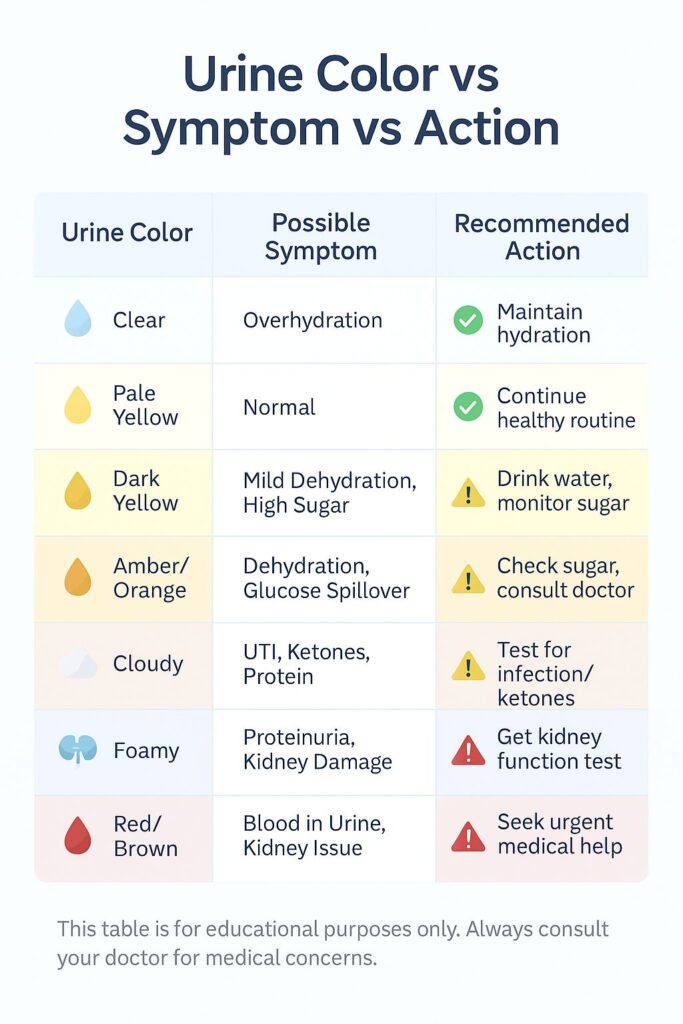Introduction: Why Urine Color Matters in Diabetes
Most people with diabetes focus on glucose meters, A1C levels, and insulin doses—but your urine color can provide equally critical clues about your health.
As a pharmacist specializing in diabetes management, I’ve counseled countless patients who ignored early signs like dark, foamy, or cloudy urine—only to later discover serious complications like diabetic nephropathy or ketoacidosis.
In this comprehensive guide, I’ll break down:
• What urine color says about your blood sugar
• Signs of dehydration, infection, or kidney damage
• When to act, and when it’s a medical emergency
(diabetes urine color, urine color in diabetes, diabetic urine symptoms, urine color high blood sugar)
The Science Behind Urine Color and Diabetes
What Is Urine Made Of?
Urine is primarily water (95%) with waste products like:
• Urea
• Creatinine
• Electrolytes
• Glucose (if blood sugar is high)
• Ketones (if the body is burning fat)
When blood sugar rises above 180 mg/dL, kidneys can’t reabsorb all the glucose, so it spills into the urine, changing its color, consistency, and smell.
Reference: American Diabetes Association
Common Urine Colors and What They Mean in Diabetes
| Urine Color | Possible Meaning | Should You Worry? |
| Clear | Hydrated, well-controlled diabetes | Normal |
| Pale Yellow | Normal urine | Normal |
| Dark Yellow | Dehydration due to high glucose | Caution |
| Amber or Brown | Kidney strain or protein spill | Needs testing |
| Cloudy | UTI or ketones | Consult doctor |
| Foamy | Protein in urine | Early nephropathy |
| Reddish | Blood in urine (hematuria) | Emergency |
| Sweet Smelling | Glucose or ketones | Sugar too high |
Pharmacist’s Insight:
I often advise patients to check their urine first thing in the morning—it gives the clearest picture of hydration, glucose spillover, and potential issues.
Why High Blood Sugar Affects Urine Color
When blood sugar is elevated:
- The kidneys filter excess glucose into urine.
- Glucose pulls water with it → polyuria (frequent urination)
- Body becomes dehydrated → dark urine
- Long-term sugar damage → protein in urine, cloudiness, foaming
Did You Know?
Uncontrolled diabetics can urinate 3–4x more frequently than non-diabetics.
Diabetic Ketoacidosis (DKA) & Urine Changes
DKA is life-threatening. It occurs when your body burns fat for fuel, producing ketones.
Urine Signs in DKA:
- Cloudy appearance
- Strong, fruity odor
- Tests positive for ketones
- Foamy or frothy (from kidney involvement)
| Test | Normal | In DKA |
| Blood Sugar | <180 mg/dl | >250 mg/dl |
| Urine Ketones | Negative | Large |
| pH | 6-7.5 | Acidic (<6) |
Learn more: Mayo Clinic on DKA
Diabetic Nephropathy – A Silent Urine Symptom
Over time, diabetes damages the glomeruli (filtering units) of the kidney, leading to:
• Protein leakage (proteinuria)
• Foamy urine
• Increased creatinine and urea levels
If untreated, it leads to chronic kidney disease and dialysis.
Warning Urine Signs:
• Persistent foam
• Swelling in ankles or face
• Fatigue or high blood pressure
More on this from: National Kidney Foundation
Visual Urine Color Chart for Diabetics

Case Studies – Real Stories from Diabetic Patients
Case #1 – Raj, 48, Type 2 Diabetic
Urine Color: Foamy, occasionally amber
Diagnosis: Microalbuminuria (early nephropathy)
Action Taken: Started ACE inhibitors + tighter glucose control
Outcome: Kidney function stabilized
Case #2 – Alisha, 24, Type 1 Diabetic
Urine Color: Cloudy and sweet-smelling during flu
Diagnosis: Early DKA
Action Taken: Hospitalization and insulin drip
Outcome: Recovered fully
How to Test Your Urine at Home
Buy These from Pharmacy:
• The Urine ketone test strips
• Urine-glucose strips
• Protein dip sticks
How to Use:
1. Collect mid-stream urine.
2. Dip strip and wait for color change.
3. Compare with chart.
When to See Your Doctor
See your doctor if:
- Urine is persistently dark or foamy
- Burning sensation or blood
- You test positive for ketones
- You feel tired, swollen, or thirsty constantly
Pharmacist Tip: Bring a urine sample and list of symptoms to your appointment.
Preventive Tips to Keep Your Urine (and Kidneys) Healthy
Do:
- Monitor blood sugar consistently
- Stay hydrated (2–3L daily)
- Take prescribed meds regularly
- Eat low-sodium, kidney-friendly meals
Don’t:
- Ignore cloudy, smelly, or foamy urine
- Skip A1C or urine microalbumin tests
- Self-medicate UTIs or pain

FAQs: Diabetes & Urine Color
1. What color is urine when blood sugar is high?
Usually dark yellow or amber due to dehydration and glucose spillover.
2. Can diabetes cause cloudy urine?
Yes. Especially in cases of infections, proteinuria, or ketones.
3. Why is my urine foamy if I have diabetes?
Likely due to protein leakage from kidney damage—needs immediate testing.
4. What should I do if my urine smells sweet?
Check your blood sugar and ketone levels. Seek urgent care if levels are above 250 mg/dL.
5. How do I prevent urine complications in diabetes?
Control blood sugar, stay hydrated, monitor urine changes, and get regular kidney checks.
Key Takeaways
- Urine color is a subtle but powerful health indicator in diabetes.
- Look out for dark, cloudy, foamy, or sweet-smelling urine.
- Stay hydrated and keep blood sugar under control.
- Use home urine tests for glucose, ketones, and protein.
- Always seek medical advice for abnormal changes.
Medical Disclaimer
This blog is for informational purposes only and does not substitute professional medical advice. Always consult your physician or diabetes educator for personalized care.



